January 28, 1982
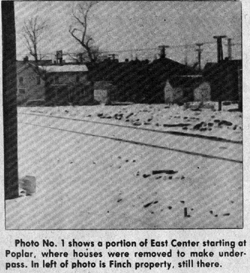
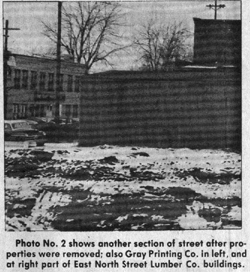
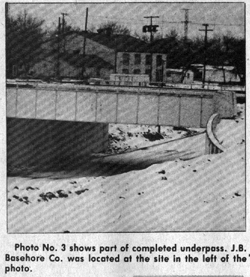
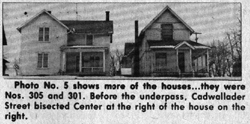
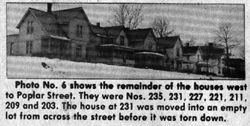
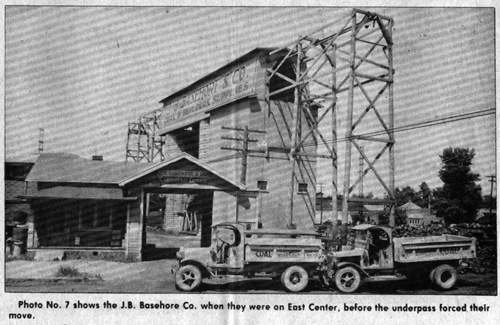
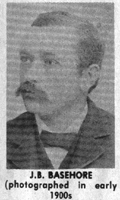
Picture #1 – shows a portion of East Center starting at Poplar, where houses were removed to make the underpass. In left of photo is Finch property, still there.
Picture #2 – shows another section of street after properties were removed; also Gray Printing Co. in left, and at right part of East North Street Lumber Co. Buildings.
Picture #3 – shows part of completed underpass. J.B. Basehore Co. was located at the site in the left of the photo.
Picture #4 – shows the old New York Central Freight Station and three of the houses which were not disturbed un the underpass program. Reading from left they were Nos. 321, 317, 313 and 309.
Picture #5 – shows more of the houses…they were Nos. 305 and 301. Before the underpass, Cadawallader Street bisected Center at the right of the house on the right.
Picture #6 – shows the remainder of the houses west to Poplar St. They were Nos. 235, 231, 227, 221, 211, 209 and 203. The house at 231 was moved into an empty lot from across the street before it was torn down.
Pix #7 – shows the J.B. Basehore Co. when they were on East Center, before the underpass forced their move.
Picture – J.B. Basehore – photographed in early 1900’s.
The area of East Center Street to be explored today (fourth and last in the series) is the section east of Poplar to the underpass.
Fostorians who have lived here for many years will recall that the railroads, which practically hemmed the iron, made it difficult to get in or out of town because of the trains. The underpasses on East Center and Wood Street solved that problem.
At the East Center underpass, J.B. Basehore Co. distributor of coal and building supplies, was forced to find a new location. Photo #7 shows their years next to the railroad tracks, which they abandoned and moved to East High Street where they are today.
Basehore is an outgrowth of a coal supplier whose origin goes back to the J.S. Baumbaugh & Co. in the 1890’s. Baumbaugh was the father-in-law of Jesse B. Basehore, the latter being the father of Les Basehore.
BASEHORE COMPANY 79 YEARS OLD
According to Les, who has been associated with the company since 1903, his father Jesse and S.G. Sheely, formed a partnership and bought out Baumbaugh in 1903. Sheely dropped out of the partnership in 1915 and became a farmer. It was his farm which was sold by Wilbur Sheely, son of S.G. to the city for developing Meadowlark Park.
When I was researching this article, I attempted to get photos from Wilbur Sheely of his father and other illustrations to show their horsedrawn wagons and sleds used to deliver coal in the earlier days. Wilbur died before he was able to locate the photos.
Civic improvements provide advantages and sometimes disadvantages, such was the case of the underpass project. It resulted in the demolition or moving of all of the houses on the north side of the street, from Poplar to the railroad, plus Basehore’s property.
On the opposite side, it resulted in the houses remaining, but left them sitting up on the hill, with access only from the rear of the premises (or from Cadwallader Street); Obviously, it resulted in great inconvenience and devalued the properties.
One of those was Lester C. Huth, 305 E. Center St., who has owned that property since 1951, but lived there through the underpass development, and continues to live there. He loaned the photos used with today’s article, showing the project as it developed.
HOUSES RAZED BY UNDERPASS
Photos No. 1, 2, and 3 show the north side where all of the houses were demolished or moved. The following list is of those who resided in those houses from 1915 until 1956 or 1957, at time of razing. No. 202: Jim Franke; Mrs. Edna Ruch; Dr. Carl L. Coburn, dentist; Mrs. Emma Allison; Robert Zavesky; Raymond A. Foster; Margaret Roskins.
No. 208: J.A. Huth; W.G. Ellenberger; J.O. Hanson; Ella Huth.
No. 210: Ephraim Stahl; Mrs. Cora M. Bricker.
No. 222: Mrs. S. Mergenthaler; C.D. Stearns; Amanda Stearns; Joseph Leonard; Cassius E. Whitman.
No. 230: J.H. Reeves; Mrs. Edna Ruch; Mrs. Nellie D. Eckert; Mrs. Myrtle M. Rensch; John W. Henry; Walter T. Boren; Milford R. Hann; Jacob Fruth; Edward W. Jackson; Clayton Stevens.
No. 232: R.R. lingenfelter; Martin Weber; Marry Weber; Helen M. Weber; Ernest E. Weissinger; John H. Kennedy.
No. 234: R.B. Spencer; Ida May Spencer.
No. 300: L.R. Covert; A.M. Dennis; J.H. Myers, Mrs. Syvilla Rosen; John H. Tuttle; Harvey Williams; Lajoie Gregory; Maurice E. Walsh; M.J. Barrett; William S. Detillian; Mrs. Maude Gregory; Raymond Wagner.
No. 304: S.C. Nusbaum; Willard Nusbaum; Mrs. Emma Rainey.
No. 308: Dominick Hoffbauer; Irvin F. Harding.
HOUSES THAT SURVIVED THE UNDERPASS
Photos No. 4, 5 and 6 show the houses that survived the underpass program, perched up on the hill. The list that follows is the residents of those houses from 1915, until recent years.
No. 203: Mrs. S. Hogan; J.A. Shutt; Blance Freese; Cricket Shutt; Clark J. Alley; Robert Hanley.
No. 209: J.J. Eissler; Mrs. Coroline Eissler; A. Louise Eissler; Rosetta Eissler; John L. Holden; Conrad Fruth; Robert C. Walters; E.A. Davis; D.L. Edinger; Clayton Risner; George C. Davis; Merle Cook; Fred Kimble.
No. 209 1/2: Leslie Johnson; Charles Glover; C.L. Gibson; Floretta Hutchinson; Clifford Latham.
No. 211: E.A. Dioon; Edward Fredritz; Elmer A. Scott; Wyneta Buley; Francis M. Weirough; Donald Greek; Floyd Roddy.
No. 221: J.M. Vrooman; Carl A. Nusser; W. Clark; Don Heckathorn; Russell Thompson; Elmer A. Scott; Jacob Fruth; Harry N. Peters; Herman Beck; Mrs. Roxie Christ; Harvey Clagg; Michael E. Zeitch; Larry Jacksy; Isabelle Willey.
No. 221 1/2: Sue Tooman; Deborah Reinhard.
No. 227: C.D. Stearns; Mrs. Elizabeth Stearns; Elmer R. Pownell; Lee M. Decker; Val Dieter; Earl Peter; B.F. Chamness; Stanley Seemuth; Thelma Huth; Gail Fillhart; James Slater; Carmel Clark; Joe Madden; Mrs. A.C. Laney; Sandra Hyden; Junior Browning; Geneva Moore; Sheila Vinson.
No. 227 1/2: J.L. Crawford; Sarah Reigel, Regina Cousin; David Thompson.
No. 231: Mae E. Fenton; Charles J. Kiser; Michael Williams; C.R. Crump; Dean Hartman; Shirley Eisenhower; Beverly Alexander; Marion Sherman.
No. 231 1/2: Sara Rinkle; C.R. Crump.
No. 235: W.W. Sayre; Amanda Sayre; Raobert Sayre; Howard Smith.
Cadwallader Street bisected at this point prior to the underpass.
No. 301: Mrs. Eva Gibens; Jacob Krieger; Emery McClung; James Jones; Sherman G. Roose; Ralph Cockrell; R.J. Childers; James W. Graves; Randall Hunt; Everatt L. Barnett; Ralph Cockrell.
No. 305: C.L. Huth; Mrs. Rose Huth; Lester G. Huth.
No. 309: J.B. Dennis; Charles A. Smith; Albert Omlor; Rollie R. Helms; Cecil A. Mng; Paul R. Wilcox; Mrs. Jessie Wilcox; Joseph B. Soals; Jeffrey Pahl.
No. 313: Carl H. Steinhour; Mrs. Ethel Steinhour.
No. 317: C.R. Morris; Clarence A. Ruch; Richard W. Hill; Ella Aber; Jesse L. Brown; Klahr Shellhouse; Pat L. Baker; Cynthia M. Krupp.
No. 321: New York Central Freight Station.
Photo No. 4 shows the old New York Central Freight Station. That railroad provided connections to Fremont via the Nickel Plate and to Kenton, Bellefontaine and Cincinnati. At Cincinnati’s beautiful Union Station, travelers could make connections for southern destinations. At Bellefontaine, connections could be made to Indianapolis and St. Louis. I rode the N.Y. Central often during earlier days. That line also provided passenger service to Detroit.
In an earlier Potluck, I mentioned that I had lived in the east end during my youth and knew every corner and many people. Here are some recollections of those who lived in the vicinity of and east of Cadwallader Street. Most of them are deceased, but there are probably some descendents still in town.
SPENCER THE ARTIST
First, I want to mention the Spencer sisters who lived in the large frame house, practically devoid of paint, at Center and Cadwallader. As I recall, it was Ida May who was the artist in the family. She always exhibited her wares at county fairs. One of her specialities was handpainted china. My younger sister, Virginia, accompanied and assisted her on some occasions. Perhaps, some readers may possess some of her productions.
There was an old wire fence that enclosed the Spencer backyard, and it was covered with honeysuckle in season. I can still recall the aroma given off by the blossoms as I passed by, especially at nighttime.
When Ida May, the last of the family died sometime in the mid 1940’s, the Gray Printing Co. purchased the house, rented it for awhile, and demolished it. It used the land for expansion of the business.
FAMILY FRIENDS
At 235, across the street from Spencers was the W.W. Sayre family. They were friends of our family. Amanda Sayre and her Aunt Hollinger conducted the Millinery store on the second floor of the building where City Loan is today.
Then there was Mrs. Eva Gibens at 301. My recollection of her was prior to my teen years and early during them. I think my grandmother, who lived with us and kept our family together, knew her from them belonging to the Grand Army of the Republic Auxiliary. Grandmother would visit with her at her house and often came home with a gift of garden vegetables by Mrs. Gibens. She often sent word to have me pick up vegetables, and that’s how I came to know her. I was impressed with her friendly generosity.
Ruth Dennis (Barnes) family lived at 309. Ruth is my age, and we both went to Whittier School. She had a sister Kathryn and an older one, whose name I can’t recall, and I believe an older brother. Ruth has lived all her life in Fostoria, and whenever we have met it was a time to stop and reminisce about childhood items in Potluck.
MORRIS THE PRINTER
The C.R. Morris family lived at 309, across from Basehore. They had a son Paul, who was one of my playmates. His father was a printer by trade and worked at Gray Printing and was instructor in George M. Gray’s school of printing. It was a training program for young men who wanted to follow that trade. The school was a highly successful program, which developed valuable employees. When the school terminated, Mr. Morris taught printing in Fostoria’s school system. Like many, Paul grew up and left town. I never saw him again but have never forgotten him.
Mrs. Maude Gregory lived at 300, and I believe worked at J.B. Rogers Co. Many readers will remember her. She had two daughters: one a redhead, the other a blond. I often wondered what became of them.
In ater years Lajoie Gregory, retired fire chief, also lived at 300. He and I have been friends all of our lives.
The Harry Frankenfield family lived just south of Center on Cadwallader. Dee, whom many readers know, was part of that family.